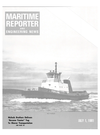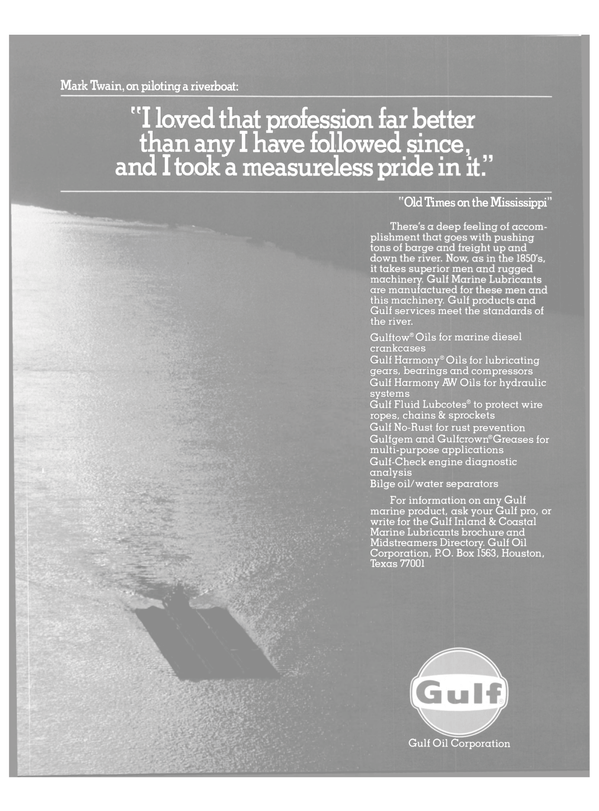
Report Available Comparing Qualities Of Synthetic Ropes
As synthetic fiber ropes are becoming more widely used in various industries and government agencies, there is a need for comprehensive engineering data to compare the various constructions.
In a specially prepared technical report for the Offshore Technology Conference, Samson Ocean Systems, Inc. tries to fulfill this need by summarizing the data obtained from a series of systematic tests for strength, elongation and energy absorption.
Currently there are three commonly used constructions: twisted (three strand) ; plaited (eight strand), and double braided. Due to its tendency to hockle or kink, twisted rope is seldom used in critical applications where hockling cannot be tolerated. In addition, strength and e l o n g a t i on data for twisted and plaited constructions are similar.
Since there are many synthetic materials available, only the most common material — nylon — was used as the basis for comparing the two constructions. This comparison generally holds true for other materials as well.
The strength, stretch and energy absorption of-double-braided and eight-strand plaited ropes are discussed in detail in the report.
The main points may be summarized briefly as follows: 1. Strength (a) Size f o r size double braid is 25 percent to 40 percent stronger.
(b) For equal weight, double braid is 15 percent to 30 percent stronger while being slightly smaller in size.
2. Elongation (a) Stretch data for new ropes should not be considered since synthetic fiber ropes stretch permanently and stiffen significantly with only a few load cycles.
(b) Plaited eight-strand ropes stretch and stiffen after use much more than double braid. For used ropes, the elongation at the breaking point differs about 9 percent between plaited rope and braided rope. This compares to a difference of 15 percent with new unused rope..(c) Under frequent cycling of load, synthetic fiber ropes stiffen significantly compared to onetime loading. Plaited rope stiffens more than double braid. On an equal size basis, the difference in elongation at the breaking point is about 3 percent. The performance of plaited and double braid is quite close under these conditions, which is representative of actual service conditions, such as mooring and towing operations.
3. Energy Absorption (a) On both a size and weight basis, double braid absorbs more energy than plaited rope when loaded to the breaking strength for all conditions (new, used, cyclic).
(b) On both a size and weight basis, double braid absorbs more energy than plaited at the same percentage of breaking strength for the used condition and the cyclic load condition.
4. Fatigue (a) Under cyclic load conditions, double braid retains its strength much longer than plaited rope.
The complete report, which is an addendum to the Samson Rope Manual, may be obtained from Samson Ocean Systems, Inc., 99 High Street, Boston, MA 02110.
For further information, Write 24 on Reader Service Card
Read Report Available Comparing Qualities Of Synthetic Ropes in Pdf, Flash or Html5 edition of July 1981 Maritime Reporter
Other stories from July 1981 issue
Content
- Secretary Lewis Announces Plan To Transfer MarAd To DOT page: 4
- Work On Two Tankers At Northwest Marine Will Total Over $7.8 Million page: 5
- $2.3 Million Awarded To SeaTec For Mooring And Pipeline Project page: 5
- Cat Introduces New Family Of High-Speed Diesels- Product Bulletin Available page: 6
- Bay Building Barge With First Conveyor To Handle Wet Phosphate Rock page: 6
- NICOR Acquires Arthur Levy Enterprises And Offshore Island Boats page: 7
- New Licensee In Japan For B&W Diesel Engines page: 7
- Robert Ware Establishes His Own Maritime Public Relations Service page: 7
- Circular Detailing New Suez Canal Regulations Available From Candia page: 7
- IMODCO Receives Order From Petrobras For $5-Million SPM Terminal page: 7
- TIW Industries And DMI Sign Agreement To Build Dredges In Canada page: 8
- Wartsila Turku Shipyards Delivers Superferry 'Silvia Regina' page: 8
- U.S. Combat Systems In Foreign Built Ships Topic At ASNE Meeting page: 8
- Todd Continues Expansion —$12-Million Drydock Ordered From Bender page: 9
- Gems Paddle Switches Monitor Flow Conditions —Literature Available page: 9
- Eller & Company Acquires Uiterwyk Cold Storage page: 9
- Puget Sound Tug & Barge Will Build 12 Barges Costing $39.5 Million page: 9
- Seaco Energy/Coastal Carriers Joint Venture Plans Floating Terminals page: 9
- Conversion Of RO/RO 'Ponce' Completed By Sun Ship page: 10
- New Torque Controller Introduced By Delaval —Literature Available page: 10
- First Of New Destroyer Class Commissioned At Ingalls Yard page: 10
- Santa Fe Diving Services Awarded Contract To Provide RCV And Crew page: 10
- National Steel Lays Keel For U.S. Navy Cable Repair Vessel page: 10
- Major Work On 'Wavertree' Performed By Bethlehem Yard page: 11
- Marathon Introduces New Super 300 Jackup For Harsh Environments page: 12
- Paper On Real Time Monitoring Presented At Pacific Northwest SNAME page: 12
- Second Crandali Dock At National Sea Products Yard Rebuilt And Enlarged page: 12
- Dravo Acquires The Ryan-Walsh Group page: 13
- Union Oil Products Carrier Launched At NASSCO Yard page: 14
- Anthony McAllister Jr. Elected Chairman Of New York Towboat Association page: 14
- $172-Million Navy Order To Bell For New Type Landing Craft page: 14
- Theriot-Modec To Build Ammonia Barge For Energy Transportation Subsidiary page: 15
- Edward Campbell Named To Board Of Trustees At Webb Institute page: 15
- M/T PORTLAND Unusual 360° Steerable Z-Drive Tug Enters Service page: 16
- $140-Million Contract For Two Offshore Rigs Awarded To Gotaverken Arendal Shipyard page: 16
- Benson, Basse And David Join Tampa Barge In Management & Production page: 16
- Delaware Valley ASNE Chapter Discusses Government Contracting page: 16
- New NKK Ship Design Will Reduce Fuel Use By Some 40 Percent page: 17
- Los Angeles SNAME Discussed Single-Point Mooring Technology page: 18
- Hudson Delivers The 'Gulf Dolphin7 To Gulf Fleet Marine page: 18
- Third Seaboard RO/RO Ordered At Fredriksstad Yard Will Have MacGregor Hoistable Decks page: 18
- Cummins Powers First Towboat Built By Brice Shipbuilding page: 19
- Brochure On Motorship Protection Program Offered By Drew Ameroid Marine page: 20
- Bethlehem Steel Names Messenger Assistant To Mgr-Ship Repair Sales page: 20
- Grumman Hydrofoil For Israel Launched At Lantana Boatyard page: 20
- Dravo-Built Towboats For China Get A Lift From Dock Express page: 20
- Report Available Comparing Qualities Of Synthetic Ropes page: 21
- Petronio Elected VP-Engineering At Pool Company Of Houston page: 21
- Two MARCO Oil Skimmers Delivered To Mexican Navy page: 21
- SHIPBOARD AUTOMATION & MONITORING SYSTEMS page: 22
- David Taylor Naval R&D Center Hosts Hydromechanics Meeting page: 22
- W.B. Buhrmann Elected President Of Newly Formed U.S. Steel Companies page: 24
- Valley Line Asks Title XI For $90.1-Million Barge And Towboat Project page: 24
- Petro Marine Services To Build $25-Million Shipyard In Alaska page: 26
- Riverway Completes Second Drydock For Its Own Repair Division page: 27
- New Brochure Describes National Crane's Line Of Marine Lifting Systems page: 27
- Shipyard Conference Honors Past Chairmen McKay And Pirozzolo page: 28
- HUDSHIP To Build Four Big Towing/Supply Vessels For Zapata page: 29
- U.S. And Canada Agree To Cooperate In Marine Transportation R &D page: 34
- Philadelphia Resins' New Brochure Describes The Company And Its Products page: 34
- Griffin & Alexander Jackup Rig Commissioned At Bethlehem-Beaumont page: 35
- Lima Electric Announces New Model Alternator- Literature Available page: 35
- Port Handbook Makes Museum Donations page: 36
- Great Lakes/Great Rivers SNAME Spring Meeting Held In Cleveland page: 36
- Raytheon Opens New Marine Sales And Service Facility In Mississippi page: 36
- Partnership Between AMCA International & McDermott Formally In Business page: 36
- Gulf Fleet Marine Names Vaccaro Contracts Manager page: 37
- Seminars On Rig Moves Organized By Marine Design International page: 37
- Bulk Carrier 'Pride Of Texas' Delivered By Levingston Shipbuilding page: 38
- Dome Acquires Davie Shipbuilding At Total Cost Of $38.6 Million page: 38
- Riverway Shipyard Delivers GM-Powered Towboat 'Waterways Explorer7 page: 38
- McAllister Reports Ship Financing Policy Now Under Government Study page: 39
- Largest DMI Dredge Delivered To Mexican Owner page: 39
- 34th Annual Statistical Analysis Released By Marine Index Bureau page: 40
- Underway Replenishment Machinery Topic At Long Beach/LA ASNE page: 40
- Rubber Fendering Reduces Damage To Vessels And Piers page: 40
- Sembawang Yard Completes Multimillion-Dollar Overhaul Job On McDermott Barge page: 40
- Mario Moor Will Head Sulzer's New Subsidiary Company In Hong Kong page: 41
- Revised Rules On Mobile Offshore Rigs Issued By Det norske Veritas page: 41
- APL Ready To Build 45-Foot Production Unit Containers page: 41
- U.S. Maritime Industry's Safety Excellence Cited At Award Ceremony page: 42
- Tracor Marine Awarded $2.5-Million Navy Contract To Manage OCEI Facilities page: 42
- Ned Smith Named Vice President-Finance For American Steamship page: 42
- Dravo To Provide People's Republic With Technical Assistance And Equipment page: 42
- IHI's New Shaft Generator System Meets Its Design Expectations page: 43
- McDermott Incorporated Promotes Four To « Vice President Posts page: 43
- Twin City Yard Lays Keel For Seagoing Split-Hull Dredge page: 44
- First Large-Scale Floating Seawater Desalination Plant Launched At Nordseewerke page: 44
- Multipurpose Cargo Vessel Launched At GHH Sterkrade Yard page: 44
- Cat-Powered Research Vessel Delivered By A t l a n t i c Marine page: 47
- Last Of Ten Supply Vessels For NMS Launched By Promet page: 47
- NASSCO-Built Destroyer Tender Delivered To Navy page: 50
- Dome Petroleum Orders Drill From Cammed Laird Yard page: 51
- ACBL Towboat 'W.T. Toutant' Launched At Jeffboat Shipyard page: 52
- Promet Launches Its Biggest Jackup For Offshore Company page: 52
- C.E. Matthews Appointed N a t i o n a l Sales Manager For Morse Controls page: 53
- Skagit Crane Provides Improved Fuel Economy —Literature A v a i l a b le page: 53
- New York Maritime Day Ceremonies Featured Presentation Of Two Awards page: 58
- Todd Shipyards Awarded Navy Study Contract On DDGX Producibility page: 58
- Butterworth Tank Washing Machines Ordered For Eight New Product Carriers page: 59
- Bulk Carrier 'Star Of Texas7 Launched At Levingston Yard page: 59
- Texaco Acquires British Tanker From Globtik page: 66
- Newest Bulkfleet Marine Tug Is Powered By MaK Diesels page: 66
- Literature Available On New Pressure-Wiper Seal For Hydraulic Cylinders page: 66
- New Brochure Describes Joy Mfg. Ship/Shore Power Connectors page: 67
- EDO Reorganized—Its Nav/Com Line Will Be Produced At Texas Plant page: 67


